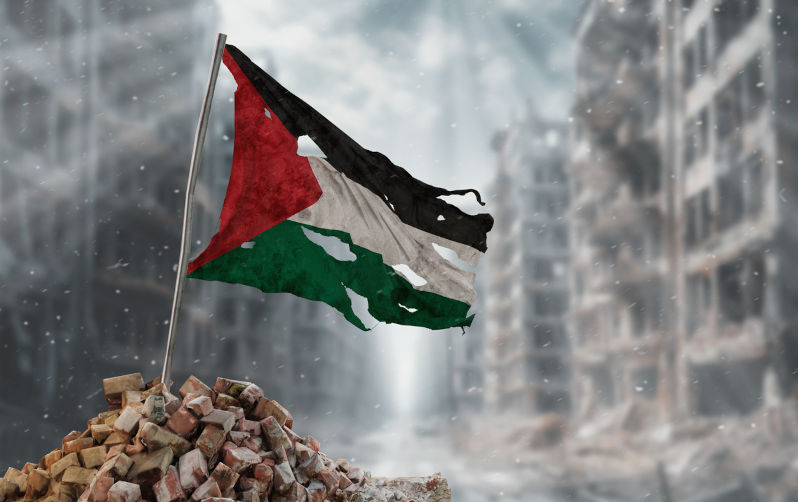The gates of Gaza
September 1, 2025
What happens when the gates of Gaza are opened?
One of the first British soldiers to enter the concentration camp at Bergen-Belsen on 15 April 1945 was John Darby. He used his tank to smash down the gates. This is his story.
“I went up to the gates,” he said, “pushed them open with the tank. I was the first there to discover it. We knew it was a camp, but it wasn’t an extermination camp – but people died and were piled up in beds and round and about like rotten logs of wood, which we could see at a distance.
“We saw young German troops were shooting at prisoners trying to climb over the wire fence, but our colonel started shooting them. I shot four. They were burning documents as fast as they could. I was standing there keeping an eye on the colonel, who was still shooting these Nazi youth, when I felt something touch my leg. I saw a hand and then I saw a face appear and saw these eyes and said, ‘It’s alright love, you’re free now’.”
The world is fast approaching the moment when independent reporters and observers will enter Gaza. Rather than tanks, it will be bulldozers that reveal the true cost, as the rubble is removed and the body count of this most recent genocide is made known.
Unlike in Nazi Germany, it is unclear who those liberators will be. But it is already clear the world will go through the political and psychological performance of the unknown/known; indeed, it is already rehearsing that role. This is where we collectively exclaim that we had no idea the number was so high — it will be 100,000 or even higher — that the starvation was more extensive than most realised and that if we had known the full extent of the slaughter we would have/should have acted.
Right now, there are two things that we must consider. The first is that this revelation will be felt as a moment of deep and bewildering shame for us – the West, the silent voices, the leadership that prevaricated. Us. And we need to handle this fragile moment very carefully, because shamed people can quickly become defensive and furious people.
Secondly, we need a plan. Right now.
Where will the two million Palestinians live while their city is rebuilt, their gardens replanted, their water supplies reconnected? How is any Palestinian expected to feel safe living so close to a nation, a people, who wanted to destroy their lives, their history, their trees and their future? Assuming, of course, Israel’s ambition of ethnic cleansing — put in harness by President Trump’s vision for a resort style US/Israel — does not succeed.
I am not in a position to answer any part of the second point. But I believe the answer will arise out of the management of the first point. That is, how do we hold that fragile moment of recognition of profound harm done?
Fortunately, we have a wealth of wisdom to draw on from the likes of Sigmund Freud to Melanie Klein to the wonderful Donald Winnicott. Beginning with the idea embodied in Freud’s paper, Mourning and Melancholia, to Melanie Klein’s work_, Thoughts on the Paranoid-Schizoid position._ These ideas circle around the need to stay in contact with reality – even when that reality is about our own brokenness and madness and loss. That we need to recognise that it is not only Palestinians who suffered loss though, of course, that is the primary loss. But we have all lost something we love and we must endure the terrible pain of that loss without pretending that we never did have those hopes, those ethics, that belief that we would never see anything like this revisited on a people. We must not collapse into the denial of melancholia by denying the loss of life and love and hope that we were better than this. We weren’t.
Watching a genocide livestreamed while being unable to do a thing to prevent it has traumatised people. We need to take this trauma seriously and understand that the recovery of Palestine is a recovery for everyone who watched her destruction. In the same way we are all — to a greater or lesser extent — complicit through silence as much as anything, we are all in need of healing. Fortunately we have a rough road map on how to navigate this difficult psychological terrain.
Northern Ireland’s 30-year armed conflict was marked by serious human rights violations, including killings, disappearances, and serious injuries. More than 3700 people were killed and more than 47,000 injured. This was a dirty, protracted war with lasting and severe impacts on victims and survivors in Northern Ireland, many of whom have been engaged in campaigning for truth, accountability and reparations for decades.
Professor Louise Mallinder, Legacy Theme Lead, Senator George J. Mitchell Institute for Global Peace, Security and Justice, explains how the parties to the Good Friday Agreement expressly recognised that “it is essential to acknowledge and address the suffering of victims of violence as a necessary element of reconciliation”. That is to acknowledge the reality of the harm done.
The negotiators left that politically-sensitive work to the Victims Commissioner, and Professor Mallinder notes that without an overarching mechanism to address the past, the justice system was forced to do much of the heavy lifting in dealing with particular cases through public inquiries, police and police ombudsman investigations, legacy inquests, civil actions and a handful of prosecutions. Not the perfect resolution, but one that keeps the truth and the reality of the violence in focus.
The world is yearning for a miracle in Gaza and, failing that, at least someone who can say to those buried alive, “It’s alright love, you’re free now.”
The views expressed in this article may or may not reflect those of Pearls and Irritations.

